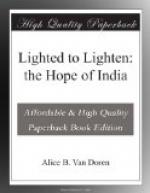“The third point is that early marriage and widowhood will be lessened in a large degree. While education will teach men and women to reverence their parents and always consult them, at the same time they will learn to choose for themselves. By coming in contact with the opposite sex, they will learn to decide their marriage themselves; and choosing does not come at an early and immature age. Thus child widowhood, too, will be decreased. Then, too, the widows will be able to work for their livelihood if they don’t wish to marry again.”
Purdah.
To the North India girl, perhaps the most vexing social question is that of purdah. How can education reach women who live shut away from the sky and the sun and the lives of men? On the other hand, if after the seclusion of a thousand years freedom were suddenly thrust upon women not even trained to desire it, who can measure the disaster that would follow? Where can the vicious circle be broken, and how?
Tiny arcs of its circumference have been broken already. Lal Bagh includes in its family not only its majority of Christian girls, but also a scattering of Hindus and Muhammadans who have made more or less of a break with ancestral customs.
One among these is a member of the Sophomore Class, Omiabala Chatterji of Allahabad. Of Brahman parentage, she was fortunate in having a father of liberal views, who was ambitious for his daughter’s education. He died when Omiabala was but three years old, but not before he had passed on to his wife his hopes for the future of the little daughter. The mother, with no experience of school life herself, but only the limited opportunity of a little teaching in her own home, yet entered into the father’s ambitions. From childhood Omiabala was taught that hers was not to be the ordinary life of the Brahman woman—she was set apart by her father’s wish, dedicated to the service of her people. So the years came and went, and instead of wedding festivities the child was sent away on the journey to Lucknow, to enter into a strange, new life. There followed weeks of homesickness and longing, then gradual adjustment, then glad acceptance of new opportunity. Omiabala now talks enthusiastically of her future plans for work among her own people—plans for the education of Brahman girls, and for marriage reform such as shall make this possible.
[Illustration: VILLAGE PEOPLE.]
The Freshman Class had a spirited discussion as to the benefits and evils of the purdah system. Opinions ranged all the way from that of the zealous young reformer who wished it abolished at once and for all; through advocates of slow changes lasting ten, twenty or even thirty years; all the way to the young Hindu wife, who would never see it done away with, “because women would become disobedient to their husbands.”
Here are some of the pros and cons. A Hindu student writes:




